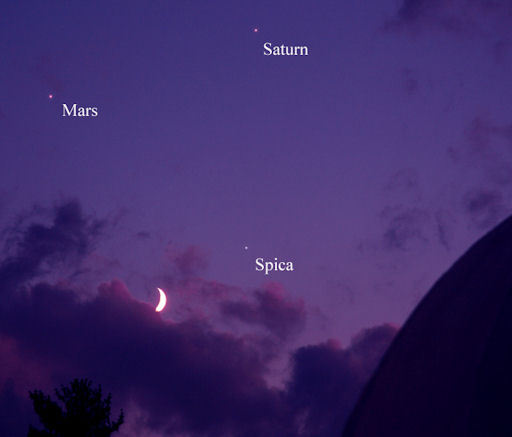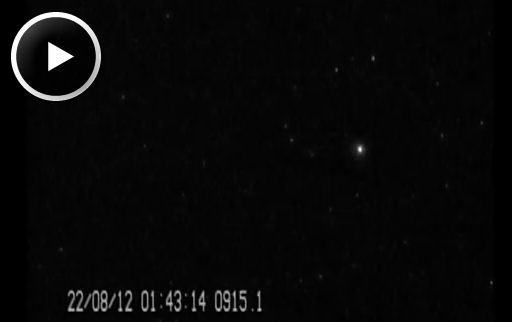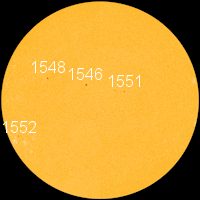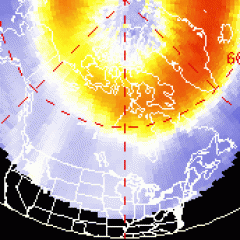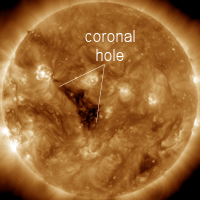QUIET SUN: With no strong flares for more than 48 hours, the sun's x-ray output has nearly flatlined. Solar activity is low, and NOAA forecasters put the odds of an X-flare today at less than 1%. Solar flare alerts: text, phone.
MARTIAN TRIANGLE: The "Martian Triangle" is back. You can see it tonight beaming through the twilight in the southwestern sky after sunset. The triangle is a triple conjunction of Mars, Saturn, and blue-giant star Spica--last seen by most people on Aug. 5th when Curiosity landed on Mars. Sky maps: Aug. 21, 22.
Last night, John Chumack photographed the trio over Yellow Springs, Ohio:
"I saw the conjunction on August 21st just before a storm rolled in on me," says Chumack. "I was dodging lightning bolts around my observatory, but still got the shot."
More images of the triangle may be found in the realtime photo gallery:
Realtime Space Weather Photo Gallery
SATELLITE THROWN OVERBOARD: On August 20th, more than 400 km above Earth, Russian cosmonauts spacewalking outside the International Space Station threw a 20-pound metal sphere into orbit. Some reporters have likened the launch to a game of Lacrosse because of the Lacrosse-style basket station commander Gennady Padalka used to propel the satellite overboard.
Last night in Brockville, Ontario, veteran satellite watcher Kevin Fetter video-recorded the "Spherical Satellite" as it passed by the 2nd-magnitude star gamma Cygnus:
"It looked to be between mag 7 and 8--too dim for the naked eye but bright enough to see in binoculars," says Fetter.
The 21-inch-wide satellite will serve as a target in space that Russian scientists will use to test space tracking techniques for monitoring space junk and to study how it re-enters Earth's atmosphere. The ball is expected to stay in orbit for about three months before falling back to Earth.

![]()
Solar wind
speed: 427.7 km/sec
density: 0.1 protons/cm3
explanation | more data
Updated: Today at 1547 UT
![]()
X-ray Solar Flares
6-hr max: B2 1248 UT Aug22
24-hr: B3 0056 UT Aug22
explanation | more data
Updated: Today at: 1500 UT
![]()
![]()
![]()
Daily Sun: 22 Aug 12
![]()
![]()
None of these sunspots poses a threat for strong flares. Credit: SDO/HMI
![]()
![]()
![]()
Sunspot number: 64
What is the sunspot number?
Updated 22 Aug 2012
Spotless Days
Current Stretch: 0 days
2012 total: 0 days (0%)
2011 total: 2 days (<1%)
2010 total: 51 days (14%)
2009 total: 260 days (71%)
Since 2004: 821 days
Typical Solar Min: 486 days
Update 22 Aug 2012
The Radio Sun
10.7 cm flux: 94 sfu
explanation | more data
Updated 22 Aug 2012
![]()
![]()
![]()
Current Auroral Oval:
![]()
Switch to: Europe, USA, New Zealand, Antarctica
Credit: NOAA/POES
![]()
![]()
![]()
Planetary K-index
Now: Kp= 2 quiet
24-hr max: Kp= 3 quiet
explanation | more data
![]()
Interplanetary Mag. Field
Btotal: 6.8 nT
Bz: 2.5 nT north
explanation | more data
Updated: Today at 1546 UT
![]()
![]()
![]()
Coronal Holes: 21 Aug 12
![]()
![]()
A stream of solar wind flowing from the indicated coronal hole should reach Earth on Aug. 26-27. Credit: SDO/AIA.

